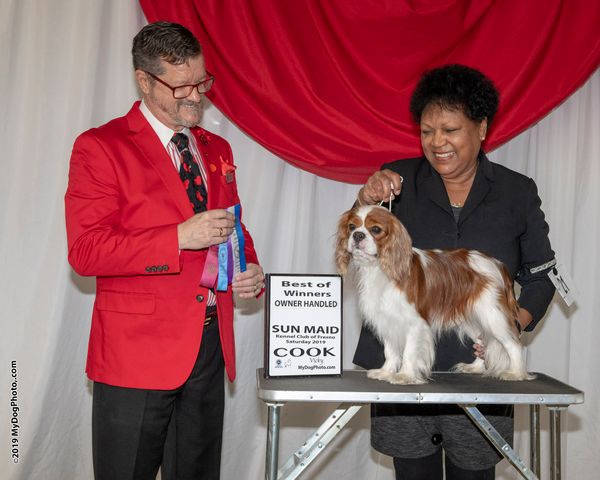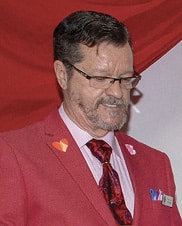Interview with Toy Group Judge Darryl Vice
1. How many years in dogs? How many years as a judge?
I started in dogs in the late seventies. I started breeding Miniature Pinschers and Brussels Griffons. I am now owed by a Kerry Blue bitch. Along the way, I also had some Working breeds, but never bred them. I started judging in 1993 with the two breeds I bred. I now judge four Groups and a couple other breeds.
Can I talk about my introduction to the Toy breeds?
I was introduced to Toys when I tried to have a Shih Tzu bred that I bought in a pet shop. When I met the person who had the stud dog, she talked me into going to a show. I started going every weekend with her and realized why she wouldn’t breed my little pet shop Shih Tzu. That’s when I fell in love with the Miniature Pinschers. She helped me find one and that was the start of my dog showing career.
Apart from size, how would I define the Toy Group?
If I was to define the Toy Group, I would separate them into two groups: the lap/companion dogs and the ratters. The lap dogs at one time were owned by royalty. These were the Pekinese, Shih Tzu, Maltese, Pug, etc. All they needed to be was pretty and love their owners, thus the [many] long-flowing coats. Then we have the ratters. These would be the Affenpinscher, Brussels Griffon, Toy Manchester, etc. These breeds were mostly brought up in the barns to keep the mice and rats cleared out. Of course, they were in the homes also, but were expected to do their jobs—and they did.
How important are presentation, conditioning and expression in the Toy breeds?
I do feel conditioning and expression are very important in the Toy Group. Expressions and conditioning are what attracted royalty to them. If the ratters weren’t conditioned with good muscling and body structure they might not have been able to keep up with the barn creatures.
Can I speak to the current overall quality of the Group?
I do believe the Group is in pretty good shape, in most breeds. Judging across the states, the Toy Group is usually one of the strongest Groups. But as in any breed in any of the Groups, this depends on the breeders and how much they pay attention to their standard when breeding. I believe that’s why some of the Toy breeds are very popular, because they are small and you can have more in your home, if breeding. With all the new regulations—even having intact animals—it is very difficult having large breeds in some cities and counties.
Why do I think so many Toy breeds are popular today?
As for more popular breeds to breed, people seem to be staying away from the longer coated breeds because of the care of the coats. The larger numbers seem to be in smooth-coated dogs, i.e., Pugs, Miniature Pinschers, etc. A lot of times there are only one or two of the coated breeds in the ring.
Advice I would give a new exhibitor?
When putting a Toy breed on the table, PLEASE train them. This is something you can practice at home on the kitchen table, having a child or someone practice going over them. The second thing is when putting them on the table, place their feet close to the edge of the table. Most new exhibitors will put them in the middle of the table. This makes the judge lean over and toward the dog, which makes the dog back up. Most dogs do not like you to lean and hover over them; this is especially true with Toy breeds. By putting them towards the edge, the judge can just walk up to the dog without leaning into them.
Any comments regarding judging Toys outdoors versus indoors?
Judging the Toys outside is similar to any breed. If the grass is longer, all dogs seem to look shorter in leg. However, the Toys can really look short; coated breeds look even worse. So I have always said, examine on the table but judge them on the ground. However, outdoors you must pay more attention to the balance of the dog; the height, the length of leg, etc. while on the table. This is when a trained dog on the table is an advantage to the dog and exhibitor. Toy breeds, in my opinion, should be indoors as much as possible. If not, the grass should be cut fresh and as short as possible. Of course, this would be up to the show committee.
Can I name one or two of my all-time favorite Toys?
It is always great to find a great dog in any breed; the ones that give you chills and you just can’t take your eyes off them. It is a wonderful feeling, going over any breed, when every angle and every muscle just flows together. These exceptional dogs don’t come to every show, but when they do it’s a prize for all. There have been great ones in many of the Toy breeds, but I will stick to my breeds. To name a few that stand out in my mind; two Griffons, “Zorro” (Rough) and “Lincoln” (Smooth), and a Min Pin, “Ivan.” These dogs were well-balanced and very typical of their breed, and they fit their standard as close as possible.
Toy breeds are so loving and easy to live with. Like all breeds, they want to make us happy. I’ve lived with many different Toy breeds for over close to 40 years, and I’ve enjoyed them all.
I do believe the Group is in pretty good shape, in most breeds. Judging across the states, the Toy Group is usually one of the strongest Groups.









